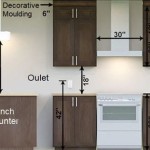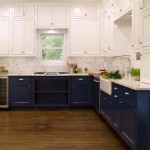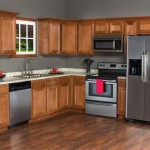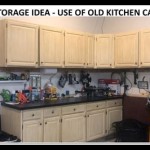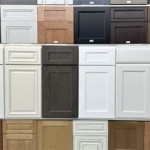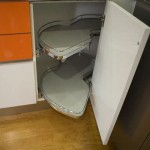How To Update Old Kitchen Cabinets With Paint
Updating kitchen cabinets with paint is a cost-effective and impactful way to revitalize the heart of a home. Instead of undertaking a full kitchen remodel, which can be disruptive and expensive, painting existing cabinets offers a significant visual upgrade for a fraction of the cost. The process requires careful preparation, selection of appropriate materials, and meticulous application techniques to achieve a durable and professional-looking finish. This article provides a detailed guide on how to successfully update old kitchen cabinets with paint.
Preparation: The Foundation of a Successful Paint Job
Proper preparation is arguably the most critical step in painting kitchen cabinets. A poorly prepared surface will compromise the adhesion of the paint, leading to chipping, peeling, and an overall unprofessional appearance. The preparation process involves several key steps, each essential for achieving a long-lasting and aesthetically pleasing result.
First, the cabinets must be thoroughly cleaned. Grease, grime, and food splatters are common in kitchens and will prevent the paint from adhering properly. Begin by removing all hardware, including knobs, pulls, hinges, and latches. Store these items carefully in labeled bags to ensure they are easily reattached later. Use a strong degreasing cleaner, such as trisodium phosphate (TSP) or a TSP substitute, to wash the cabinets. Follow the manufacturer's instructions carefully, paying close attention to safety precautions, as TSP can be irritating to the skin and eyes. Rinse the cabinets thoroughly with clean water and allow them to dry completely.
Next, assess the cabinets for any damage, such as dents, scratches, or chips. Fill these imperfections with wood filler, following the product instructions. Allow the wood filler to dry completely and then sand it smooth with fine-grit sandpaper (180-220 grit). Sanding not only smooths out the repairs but also creates a slightly roughened surface that promotes better paint adhesion. Sand all cabinet surfaces lightly, even those without visible damage. This process, known as scuff sanding, helps to remove any remaining gloss and create a more receptive surface for the primer.
After sanding, it is crucial to remove all sanding dust. Use a tack cloth or a damp cloth to wipe down the cabinets thoroughly. Ensure that all surfaces are clean and dust-free before proceeding to the next step. Masking off areas that are not being painted, such as walls, countertops, and flooring, is also essential. Use painter's tape to create clean, crisp lines and protect these surfaces from accidental paint splatters.
Selecting the Right Paint and Primer
Choosing the appropriate paint and primer is critical for achieving a professional and durable finish on kitchen cabinets. The type of paint and primer selected will influence the appearance, longevity, and ease of maintenance of the painted cabinets.
Primer serves as a crucial base coat, providing several benefits. It ensures proper adhesion of the paint to the cabinet surface, seals porous materials, and helps to block stains from bleeding through the paint. A high-quality primer is especially important when painting cabinets made of wood, laminate, or melamine. For wood cabinets, an oil-based primer is often recommended, as it provides excellent adhesion and stain-blocking properties. However, oil-based primers require more time to dry and clean up. Alternatively, a water-based primer is a good option for laminate or melamine cabinets. Ensure that the primer is compatible with the type of paint being used.
When selecting paint for kitchen cabinets, consider both oil-based and water-based options. Oil-based paints offer a durable, hard finish that is resistant to scratches and stains. They are also known for their excellent leveling properties, which result in a smooth, even surface. However, oil-based paints have a strong odor, require mineral spirits for cleanup, and tend to yellow over time, especially in lighter colors. Water-based paints, such as acrylic or latex paints, are low in odor, easy to clean with soap and water, and less prone to yellowing. They are also more environmentally friendly. Modern water-based paints have significantly improved in terms of durability and are now a popular choice for kitchen cabinets. Choose a paint specifically designed for cabinets or furniture, as these paints are formulated to withstand the wear and tear of daily use.
The paint sheen is another important consideration. A satin or semi-gloss finish is typically recommended for kitchen cabinets. These sheens are durable, easy to clean, and offer a subtle shine that enhances the appearance of the cabinets. Avoid using flat or matte paints, as they are more porous and difficult to clean. High-gloss paints, while durable, can highlight imperfections in the cabinet surface.
Sample painting is recommended before committing to a particular color. Apply a small amount of the chosen paint color to a discrete area of the cabinet or a sample board and allow it to dry completely. Evaluate the color in different lighting conditions to ensure that it meets expectations. Consider the overall color scheme of the kitchen and choose a paint color that complements the existing countertops, backsplash, and flooring.
Application Techniques for a Professional Finish
The application technique used to paint kitchen cabinets is pivotal in achieving a smooth, even, and professional-looking finish. Careful attention to detail and the use of appropriate tools are essential for success.
Spray painting is often considered the best method for painting kitchen cabinets, as it produces a smooth, flawless finish with minimal brushstrokes. A high-volume, low-pressure (HVLP) sprayer is a suitable option for DIYers. However, spray painting requires careful masking and ventilation to protect surrounding areas from overspray. It also requires practice to achieve consistent coverage without drips or runs. If using a sprayer, thin the paint according to the manufacturer's instructions to ensure proper atomization and flow.
If a sprayer is not available or preferred, painting with a brush and roller is a viable alternative. Use a high-quality brush with synthetic bristles for applying paint to detailed areas, such as cabinet doors and trim. A small, dense foam roller is ideal for painting larger, flat surfaces, such as cabinet sides and frames. Apply the paint in thin, even coats, working in the direction of the wood grain. Avoid applying too much paint at once, as this can lead to drips and runs. Allow each coat to dry completely before applying the next.
Sanding between coats is essential for achieving a smooth finish. After each coat of paint has dried, lightly sand the surface with fine-grit sandpaper (320-400 grit). This will remove any imperfections, such as dust particles or brushstrokes, and create a smoother surface for the next coat of paint. Wipe down the cabinets thoroughly with a tack cloth to remove all sanding dust before applying the next coat. Apply at least two coats of paint to achieve full coverage and a durable finish. For darker colors or surfaces with existing stains, a third coat may be necessary.
Once the final coat of paint has dried completely, allow the cabinets to cure for several days before reattaching the hardware. Curing allows the paint to fully harden and become more resistant to scratches and chips. When reattaching the hardware, use new screws if necessary to ensure a secure fit. Clean any excess paint from the hardware before reattaching it. Finally, inspect the painted cabinets for any imperfections and touch up any areas as needed. With careful preparation, the right materials, and meticulous application techniques, it is possible to transform old kitchen cabinets with paint, creating a refreshed and updated look for the entire kitchen.

How To Paint Kitchen Cabinets In 7 Simple Steps

How To Make Old Cabinets Look New With Paint

Avoid These Mistakes How To Paint Cabinets That Are Already Painted Grace In My Space

Budget Kitchen Renovation With Diy Shaker Painted Cabinets I

How To Re Paint Your Yucky White Cabinets

Tips On How To Paint Kitchen Cabinets Cherished Bliss

How To Repaint Kitchen Cabinets Painted By Kayla Payne

Diy Painted Oak Kitchen Cabinets Makeover

Painted Kitchen Cabinets One Year Later The Palette Muse

Budget Friendly Kitchen Makeover Ideas To Update Your
Related Posts


